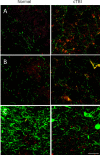Mild closed head traumatic brain injury-induced changes in monoamine neurotransmitters in the trigeminal subnuclei of a rat model: mechanisms underlying orofacial allodynias and headache
- PMID: 28761433
- PMCID: PMC5514875
- DOI: 10.4103/1673-5374.208594
Mild closed head traumatic brain injury-induced changes in monoamine neurotransmitters in the trigeminal subnuclei of a rat model: mechanisms underlying orofacial allodynias and headache
Abstract
Our recent findings have demonstrated that rodent models of closed head traumatic brain injury exhibit comprehensive evidence of progressive and enduring orofacial allodynias, a hypersensitive pain response induced by non-painful stimulation. These allodynias, tested using thermal hyperalgesia, correlated with changes in several known pain signaling receptors and molecules along the trigeminal pain pathway, especially in the trigeminal nucleus caudalis. This study focused to extend our previous work to investigate the changes in monoamine neurotransmitter immunoreactivity changes in spinal trigeminal nucleus oralis, pars interpolaris and nucleus tractus solitaries following mild to moderate closed head traumatic brain injury, which are related to tactile allodynia, touch-pressure sensitivity, and visceral pain. Our results exhibited significant alterations in the excitatory monoamine, serotonin, in spinal trigeminal nucleus oralis and pars interpolaris which usually modulate tactile and mechanical sensitivity in addition to the thermal sensitivity. Moreover, we also detected a robust alteration in the expression of serotonin, and inhibitory molecule norepinephrine in the nucleus tractus solitaries, which might indicate the possibility of an alteration in visceral pain, and existence of other morbidities related to solitary nucleus dysfunction in this rodent model of mild to moderate closed head traumatic brain injury. Collectively, widespread changes in monoamine neurotransmitter may be related to orofacial allodynhias and headache after traumatic brain injury.
Keywords: facial and somatic allodynia; headache; migraine; mild to moderate traumatic brain injury; nerve regeneration; neural regeneration; neuromodulators; thermal hyperalgesia; trigeminal sensory system.
Conflict of interest statement
Conflicts of interest: There is no financial, personal, or other form of conflict of interest among all the authors or the organizations they are affiliated with.
Figures




Similar articles
-
Trigeminal neuroplasticity underlies allodynia in a preclinical model of mild closed head traumatic brain injury (cTBI).Neuropharmacology. 2016 Aug;107:27-39. doi: 10.1016/j.neuropharm.2016.03.016. Epub 2016 Mar 10. Neuropharmacology. 2016. PMID: 26972829 Free PMC article.
-
Identification of brain areas in mice with peak neural activity across the acute and persistent phases of post-traumatic headache.Cephalalgia. 2023 Nov;43(11):3331024231217469. doi: 10.1177/03331024231217469. Cephalalgia. 2023. PMID: 38016977 Free PMC article.
-
Frequent mild head injury promotes trigeminal sensitivity concomitant with microglial proliferation, astrocytosis, and increased neuropeptide levels in the trigeminal pain system.J Headache Pain. 2017 Dec;18(1):16. doi: 10.1186/s10194-017-0726-1. Epub 2017 Feb 7. J Headache Pain. 2017. PMID: 28176234 Free PMC article.
-
Peripheral and Central Mechanisms of Persistent Orofacial Pain.Front Neurosci. 2019 Nov 13;13:1227. doi: 10.3389/fnins.2019.01227. eCollection 2019. Front Neurosci. 2019. PMID: 31798407 Free PMC article. Review.
-
Mechanisms of orofacial pain control in the central nervous system.Arch Histol Cytol. 2006 Jun;69(2):79-100. doi: 10.1679/aohc.69.79. Arch Histol Cytol. 2006. PMID: 16819148 Review.
Cited by
-
Strain in the Midbrain: Impact of Traumatic Brain Injury on the Central Serotonin System.Brain Sci. 2024 Jan 5;14(1):51. doi: 10.3390/brainsci14010051. Brain Sci. 2024. PMID: 38248266 Free PMC article. Review.
-
Preclinical Studies of Posttraumatic Headache and the Potential Therapeutics.Cells. 2022 Dec 30;12(1):155. doi: 10.3390/cells12010155. Cells. 2022. PMID: 36611947 Free PMC article. Review.
-
Gut-Brain Crosstalk and the Central Mechanisms of Orofacial Pain.Brain Sci. 2023 Oct 13;13(10):1456. doi: 10.3390/brainsci13101456. Brain Sci. 2023. PMID: 37891825 Free PMC article. Review.
-
Executive (dys)function after traumatic brain injury: special considerations for behavioral pharmacology.Behav Pharmacol. 2018 Oct;29(7):617-637. doi: 10.1097/FBP.0000000000000430. Behav Pharmacol. 2018. PMID: 30215621 Free PMC article. Review.
-
A Systematic Review of Closed Head Injury Models of Mild Traumatic Brain Injury in Mice and Rats.J Neurotrauma. 2019 Jun;36(11):1683-1706. doi: 10.1089/neu.2018.6127. Epub 2019 Mar 6. J Neurotrauma. 2019. PMID: 30661454 Free PMC article.
References
Grants and funding
LinkOut - more resources
Full Text Sources
Other Literature Sources
Miscellaneous

